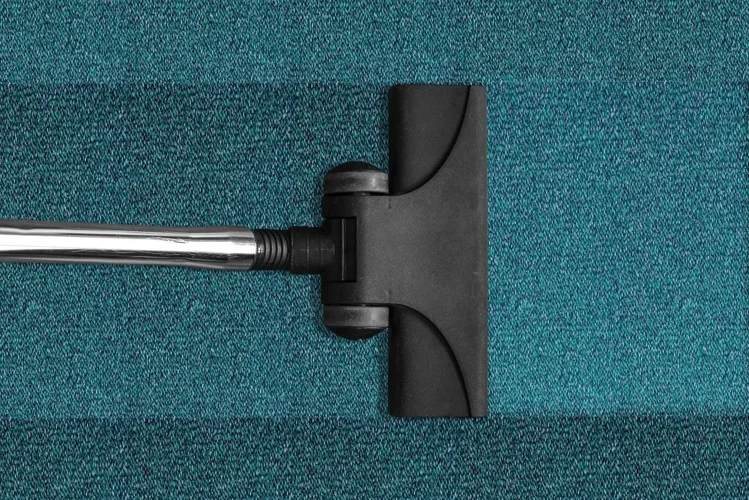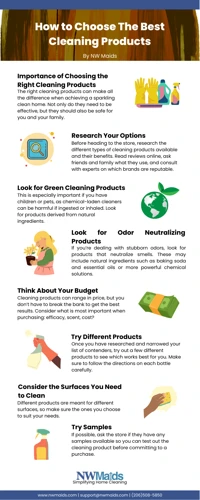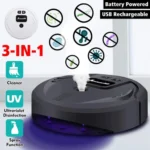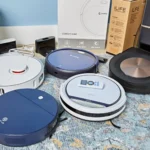When it comes to keeping our homes clean and tidy, vacuum cleaners are an essential tool. However, with growing concerns about the impact of traditional vacuum cleaners on the environment and our health, many homeowners are turning to eco-friendly alternatives. But what exactly are the advantages and disadvantages of using such vacuum cleaners? In this article, we’ll explore the benefits and drawbacks of using eco-friendly vacuum cleaners, and help you make an informed decision about whether they’re right for you.
Advantages of Using Eco-Friendly Materials in Vacuum Cleaners

Switching to eco-friendly materials in vacuum cleaners has become a growing trend in recent years. Many people are now looking for products that are not only efficient but also environmentally friendly. Using eco-friendly materials in vacuum cleaners can provide a number of benefits that are worth considering. From the reduction of carbon footprint to the promotion of healthier homes, this article sheds light on the various advantages of eco-friendly vacuum cleaners.
1. Better for the Environment
One of the major advantages of using eco-friendly materials in vacuum cleaners is that it is better for the environment. With global warming and climate change posing a threat to our planet, it is important to switch to sustainable options. Here are some ways in which eco-friendly materials in vacuum cleaners can benefit the environment:
- Reduced Carbon Footprint: Traditional vacuum cleaners release harmful chemicals and gases into the air, which can contribute to air pollution. In contrast, vacuum cleaners made from renewable and biodegradable sources such as bamboo or recycled plastics have a lower carbon footprint.
- Better Waste Management: Vacuum cleaners made from eco-friendly materials can be recycled or repurposed, reducing waste and promoting a circular economy. In contrast, traditional vacuum cleaners made from non-biodegradable materials can end up in landfills, taking up space and harming the environment.
- Conservation of Resources: Eco-friendly materials such as bio-plastics or upcycled materials require fewer resources to produce than traditional plastics or synthetic fabrics. This means cutting down on the use of materials such as oil and reducing the energy needed to produce these materials.
- Support for Sustainable Industries: By purchasing a vacuum cleaner made from eco-friendly materials, you are stimulating the growth of sustainable industries that are committed to reducing their carbon footprint and supporting the environment. This creates a positive impact on the economy and the society as a whole.
Opting for eco-friendly materials in vacuum cleaners is a step towards a sustainable and greener future. It might have a higher initial cost, but it has long-term benefits for the environment, our health, and the economy. As a responsible consumer, you can make a difference by making conscious choices and switching to products that are better for the planet.
2. Better for Your Health
Using eco-friendly materials in vacuum cleaners is not only beneficial for the environment, but also for your health. Let’s take a closer look at how eco-friendly vacuum cleaners can benefit your health.
Reduced Exposure to Toxins: Many traditional vacuum cleaners are made from plastic and other materials that emit harmful chemicals when heated or worn down. These chemicals can cause a range of health problems, such as respiratory issues, headaches, and dizziness. However, eco-friendly vacuum cleaners are made from non-toxic, sustainable materials like bamboo, recycled plastic, and other bio-plastics that don’t emit toxins.
Better Air Quality: Traditional vacuum cleaners can also release dust and other allergens back into the air you breathe. However, eco-friendly vacuum cleaners are designed to trap and remove these particles more effectively, resulting in better air quality in your home.
Reduced Noise Pollution: Traditional vacuum cleaners can be loud and disruptive, which can lead to stress, fatigue, and hearing damage over time. Eco-friendly vacuum cleaners, on the other hand, are designed to be quieter and more efficient, resulting in a more peaceful cleaning experience.
| Advantages of Eco-friendly Vacuum Cleaners for Your Health | How it Benefits You |
|---|---|
| Reduced Exposure to Toxins | Prevents respiratory issues, headaches, dizziness, and other health problems caused by inhaling toxins. |
| Better Air Quality | Removes dust and allergens more effectively, resulting in better air quality and reducing the risk of allergies and respiratory problems. |
| Reduced Noise Pollution | Provides a quieter, less disruptive cleaning experience, reducing stress, fatigue, and the risk of hearing damage over time. |
When it comes to your health, choosing an eco-friendly vacuum cleaner can have many benefits. Not only will you be reducing your exposure to toxins, you’ll also be improving indoor air quality and reducing noise pollution. Additionally, many eco-friendly vacuum cleaners come with other health-focused features like HEPA filtration, which traps even the smallest debris, and bagless designs which reduce exposure to the vacuuming process. So, opt for an eco-material vacuum to reap the health benefits of a more sustainable lifestyle.
Bio-plastics are one growing material choice for eco-friendly vacuum cleaners, but the field of future eco-materials is continuously changing with advancements in technology.
3. Longer Lasting
Eco-friendly vacuum cleaners have longer life spans compared to traditional models due to the materials used in their production. The use of high-quality materials such as recycled plastics, biodegradable components, and reusable parts greatly contribute to their superior durability.
Eco-friendly vacuum cleaners also tend to have better quality parts because eco-friendly materials are more durable and resistant to wear and tear compared to those used in traditional vacuum cleaners. They are made with better quality filtration systems, motor components, and dustbins that can last longer compared to traditional vacuum cleaners.
Another reason why eco-friendly vacuum cleaners last longer is because they are designed to be easily maintained and repaired. Many of these models come with replaceable parts, allowing users to fix any issues that may arise over time rather than having to replace the entire vacuum.
The use of eco-friendly materials in vacuum cleaners results in a product that can last you many years, making it a worthwhile investment for those looking to reduce their environmental impact while saving money in the long run.
The longer lifespan of an eco-friendly vacuum cleaner is due to the high-quality, durable materials used in their production. By using environmentally sustainable materials, these vacuum cleaners are made to withstand more wear and tear over time, making them a smart and responsible choice for consumers.
4. Energy Efficient
One of the key advantages of using eco-friendly materials in vacuum cleaners is that they are more energy efficient than traditional vacuum cleaners. This means that they use less energy to operate, which is better for the environment and your wallet.
Eco-friendly vacuum cleaners typically have energy-efficient motors that use less power to operate. They are often designed to use less energy when cleaning different surfaces, so you don’t have to worry about wasting energy when cleaning your home. This is especially important when you consider that many traditional vacuum cleaners can use up to 2,000 watts of power or more, while eco-friendly vacuum cleaners can use as little as 700 watts.
In addition to using less energy, eco-friendly vacuum cleaners may also be designed with power-saving features like automatic shut-off or power-saving modes. These features can help you save energy and reduce your monthly utility bill.
By using less energy, eco-friendly vacuum cleaners can help reduce your carbon footprint and have a positive impact on the environment. They can also help you save money on your energy bills, which is a win-win situation.
However, it’s important to note that not all eco-friendly vacuum cleaners are created equal. Some may be more energy efficient than others, so it’s important to do your research before making a purchase.
In conclusion, if you’re looking for a vacuum cleaner that is both eco-friendly and energy efficient, consider looking for models that are specifically designed with these features in mind. Look for models that have high energy efficiency ratings and power-saving features like automatic shut-off, and consider investing in high-quality eco-friendly materials like recycled plastic or biodegradable vacuum bags. By making a conscious choice to use an eco-friendly vacuum, you’ll not only be doing your part for the environment, but you’ll also be saving yourself money in the long run.
5. Can Be Recycled
Using eco-friendly materials in vacuum cleaners is not only beneficial for the environment and your health, but it also has the advantage of being recyclable. Instead of contributing to the world’s increasing pile of waste, eco-friendly vacuum cleaners can be properly disposed of without causing damage to the environment.
The following are some of the materials used in eco-friendly vacuum cleaners that can be recycled:
- Plastic – Many parts of eco-friendly vacuum cleaners can be made of recycled plastic, which can be melted and reformed. New vacuum cleaners can be made using the recycled plastic, reducing the need for raw materials.
- Aluminum – Some vacuum cleaner models may contain aluminum in parts such as the wand or motor housing. This metal can be easily recycled and turned into new products, reducing waste in landfills and conserving raw materials.
- Steel – The vacuum cleaner’s body or frame may contain steel, which is also recyclable. Steel is one of the most recycled materials in the world, and it can be used to make a variety of products, including new vacuum cleaners.
- Bio-based materials – Some eco-friendly vacuum cleaners use bio-based materials, such as biodegradable cornstarch. These materials can be broken down in a composting facility, reducing the amount of waste that goes to landfills.
Recycling these materials reduces the need for virgin materials, thereby reducing the environmental impacts related to raw material extraction, processing, and transportation. By opting for an eco-material vacuum, you will be making a positive impact on the planet.
Recycling is a crucial part of a circular economy, as it helps to conserve resources and reduce waste. When you recycle a vacuum cleaner or any other product, you are essentially extending the life cycle of that product, and minimizing the amount of waste that ends up in landfills. By choosing an eco-friendly vacuum cleaner with recycling capabilities, you are investing in both your home and the environment.
However, it is important to note that not all recycling processes are created equal, and some can have negative impacts on the environment. It is therefore critical to use recyclers who observe sustainable practices that go beyond just collecting and sorting items. These facilities should prioritize upcycling over recycling, as upcycling involves turning waste into a more valuable product, while recycling largely involves breaking down waste and turning it into a lower-grade material. By upcycling, we can maximize the value of materials and minimize the amount of waste generated.
If you are looking to minimize waste and support the circular economy, a bio vacuum bag might be worth considering. Although more expensive than regular vacuum bags, these biodegradable bags can be composted, rather than sent to landfill sites. For more information on bio vacuum bags, check out our article on whether bio vacuum bags are worth it.
Disadvantages of Using Eco-Friendly Materials in Vacuum Cleaners
When it comes to choosing a vacuum cleaner, the use of eco-friendly materials has begun to grow in popularity. However, despite the many benefits of using these materials, there are also a few downsides that users should consider. In this section, we will explore several disadvantages of eco-friendly materials in vacuum cleaners that buyers should be aware of before making a purchase. From cost to availability and cleaning power, there are several potential downsides of choosing an eco-material vacuum.
1. More Expensive
One of the biggest disadvantages of using eco-friendly materials in vacuum cleaners is that they tend to be more expensive than conventional vacuum cleaners made with non-eco-friendly materials. This is because eco-friendly materials tend to cost more to produce, and the manufacturers may have to invest in new equipment to make their production processes more environmentally friendly.
To give you an idea of the price difference, let’s compare two popular vacuum cleaners: the Dyson V11 Animal Cordless Vacuum and the Bissell PowerForce Helix Bagless Upright Vacuum. The Dyson V11 Animal Cordless Vacuum is known for its eco-friendliness and costs about $599, while the Bissell PowerForce Helix Bagless Upright Vacuum costs only about $89.99.
While the Dyson V11 Animal Cordless Vacuum has plenty of benefits, such as being cordless, lightweight, and easy to use, the price difference between the two vacuums is significant. For many people, the higher price tag may be a deal-breaker, especially if they are looking for a basic vacuum for daily household cleaning tasks.
However, it is essential to remember that investing in an eco-friendly vacuum cleaner can be a wise choice in the long run, as it can save you money on energy bills and maintenance costs. Additionally, the eco-friendly materials used in these vacuums tend to be more durable, so you may not have to replace your vacuum as frequently.
So, if you are concerned about the environment and prefer to use eco-friendly products, it is worth considering investing in an eco-friendly vacuum cleaner, even if it means paying a higher upfront cost.
You can learn more about the importance of using eco-friendly materials in vacuum cleaners by reading our article on Eco-Friendly Materials for Vacuum Cleaners. Additionally, you can learn more about the benefits of recycling by reading our article on Recycled vs. Upcycled Materials for the Environment.
2. Limited Availability
One of the major disadvantages of eco-friendly vacuum cleaners is their limited availability. Unlike traditional vacuum cleaners, which are available in almost every home goods store, eco-friendly vacuum cleaners may not be as easy to find. This may be due to the fact that eco-friendly vacuum cleaners are still relatively new to the market and are not yet as popular as traditional vacuum cleaners.
Here are some reasons why eco-friendly vacuum cleaners may have limited availability:
- Limited Production: Since eco-friendly vacuum cleaners are made using environmentally sustainable materials, their production may be limited compared to traditional vacuum cleaners. Manufacturers may not have the capacity to produce large quantities of eco-friendly vacuum cleaners as they may lack access to eco-friendly materials, leading to limited availability in stores.
- Expensive Production: The process of creating eco-friendly vacuum cleaners may be expensive due to the higher cost of environmentally sustainable materials. As a result, manufacturers may not produce them in large quantities leading to limited availability in stores.
- Low Demand: While the demand for eco-friendly products is increasing, it is still not as high as that of traditional products. This may lead to stores not stocking eco-friendly vacuum cleaners in large quantities, leading to limited availability for potential buyers.
- Target Market: Eco-friendly vacuum cleaners may be targeted towards a specific market, such as environmentally conscious individuals. As a result, stores may not stock them in large quantities, leading to limited availability.
While limited availability may be a disadvantage, it is important to note that with the increasing demand for eco-friendly products, manufacturers may increase production, leading to greater availability in the market.
3. May Not Have Same Cleaning Power
One potential disadvantage of using eco-friendly materials in vacuum cleaners is that they may not have the same cleaning power as their non-eco-friendly counterparts. This is because eco-friendly materials tend to be less harsh and abrasive, which can impact their ability to effectively clean surfaces. Let’s explore this further with the help of a table:
| Eco-friendly Vacuum Cleaners | Non-eco-friendly Vacuum Cleaners |
|---|---|
| May have a lower suction power due to the use of less harsh materials | Tend to have a higher suction power due to the use of harsher materials and chemicals |
| Can struggle with tough stains and deep-set dirt | May be more effective at removing tough stains and deep-set dirt |
| May require multiple passes over the same area to achieve an optimal level of cleanliness | May require fewer passes over the same area to achieve an optimal level of cleanliness |
As you can see, while eco-friendly vacuum cleaners tend to be better for the environment and your health, they may not always provide the same level of cleaning power as their non-eco-friendly counterparts. This is something to consider when choosing a vacuum cleaner, especially if you have specific cleaning needs or require an especially powerful suction. However, it’s worth noting that many eco-friendly vacuum cleaners are still highly effective at cleaning, and may make up for their slightly lower cleaning power through other features such as specialized attachments or innovative design. Ultimately, the best vacuum cleaner for you will depend on a range of factors, including your cleaning needs, lifestyle and personal preferences.
4. Limited Color and Style Options
When it comes to eco-friendly vacuum cleaners, there is one minor drawback to keep in mind – the limited color and style options.
While traditional vacuum cleaners come in a wide range of colors and styles to fit any interior design, eco-friendly vacuum cleaners don’t have as many options. This can make it challenging for consumers who want their vacuum cleaner to blend seamlessly with their home decor.
However, it’s important to keep in mind that the limited color and style options should not be a dealbreaker. When it comes to selecting a vacuum cleaner, it’s more important to consider its functionality and environmental impact rather than its appearance.
That being said, manufacturers of eco-friendly vacuum cleaners are starting to become more aware of the importance of style and design. There are increasingly more options on the market that come in sleek and modern designs, although they may still be limited in color options.
Here is a table to compare the color and style options of traditional vacuum cleaners versus eco-friendly vacuum cleaners:
| Traditional Vacuum Cleaners | Eco-Friendly Vacuum Cleaners |
|---|---|
| Wide range of colors and styles | Limited color options and style choices |
| May have more aesthetically pleasing designs | Increasingly more sleek and modern designs becoming available |
In conclusion, while eco-friendly vacuum cleaners may have limited color and style options, this should not be a major deciding factor in selecting a vacuum cleaner. It’s important to prioritize functionality and environmental impact over appearance, and there are still plenty of stylish options available for eco-conscious consumers.
Conclusion
In conclusion, using eco-friendly materials in vacuum cleaners has both advantages and disadvantages. While they are better for the environment and your health, they may be more expensive and have limited availability. Despite these drawbacks, the benefits of eco-friendly vacuum cleaners cannot be ignored.
After all, by choosing to use sustainable materials, we are taking a step towards a cleaner and healthier future for the planet and ourselves. We are also reducing our carbon footprint and contributing to the fight against climate change. It’s important to remember that every small change we make can have a big impact.
On the other hand, it’s essential to bear in mind that these eco-friendly options may not have the same cleaning power as traditional vacuum cleaners. However, with advances in technology, the gap is closing, and there are many options available to suit individual needs and preferences. In addition, some manufacturers are now producing eco-friendly vacuum cleaners that are just as powerful as traditional ones.
In conclusion, if you are looking to purchase a new vacuum cleaner, it’s worth considering the eco-friendly options available. By doing so, you can help to protect both your health and the environment, while also saving energy and money in the long run. Overall, the benefits of using eco-friendly materials in vacuum cleaners are significant and should not be overlooked.
Frequently Asked Questions
1. Are eco-friendly vacuum cleaners more expensive?
Yes, they can be more expensive since they are made with specialized and sustainable materials that cost more. However, they can save you money in the long run due to their energy efficiency and longer lifespan.
2. Do eco-friendly vacuum cleaners work as well as traditional ones?
It depends on the model and brand, but many eco-friendly vacuum cleaners can clean just as effectively as non-eco-friendly models.
3. How are eco-friendly vacuum cleaners better for the environment?
Eco-friendly vacuum cleaners are made with sustainable materials and use less energy, resulting in less electricity usage and less waste generated.
4. Can eco-friendly vacuum cleaners be recycled?
Yes, many eco-friendly vacuum cleaners can be recycled since they are made with recyclable materials. Be sure to check with your local recycling center for proper disposal methods.
5. Are eco-friendly vacuum cleaners quieter than traditional ones?
Eco-friendly vacuum cleaners may not necessarily be quieter than traditional ones; it depends on the specific model and brand.
6. Can eco-friendly vacuum cleaners save me money on my electricity bill?
Yes, since eco-friendly vacuum cleaners use less energy than traditional ones, they can end up saving you money on your electricity bill in the long run.
7. Do eco-friendly vacuum cleaners have any health benefits?
Yes, eco-friendly vacuum cleaners can be better for your health since they do not emit harmful chemicals or allergens while cleaning.
8. Are eco-friendly vacuum cleaners more difficult to maintain?
No, eco-friendly vacuum cleaners are not necessarily more difficult to maintain than traditional ones. It depends on the specific model and brand.
9. Can I find eco-friendly vacuum cleaners in different styles and colors?
There may be limited style and color options for eco-friendly vacuum cleaners, but more options are becoming available as eco-friendliness becomes more popular.
10. Are there any tax incentives for using eco-friendly vacuum cleaners?
It depends on your location and current tax laws. Be sure to check with your local and national tax agencies for any potential tax incentives for using eco-friendly appliances.








